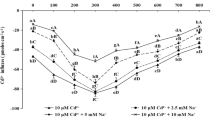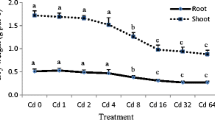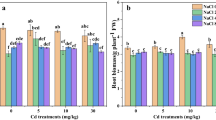Abstract
Bidens pilosa L. has been confirmed to be a potential Cd hyperaccumulator by some researchers, but the dynamic and real-time uptake of Cd2+ influx by B. pilosa root apexes was a conundrum up to now. The aim of our study was to investigate the effects of salinity and pH variations on the characteristics of Cd2+ influx around the root apexes of B. pilosa. The tested seedlings of B. pilosa were obtained by sand culture experiments in a greenhouse after 1 month from germination, and the Cd2+ influxes from the root apex of B. pilosa under Cd treatments with different salinity and pH levels were determined with application of non-invasive micro-test technology (NMT). The results showed that Cd2+ influxes at 300 μm from the root tips decreased under Cd treatments with 5 mM and 10 mM NaCl, as compared to Cd stress alone. However, Cd treatments with 2.5 mM NaCl had little effect on the net Cd2+ influxes, as compared to Cd treatments alone. Importantly, Cd treatments at pH = 4.0 markedly increased Cd2+ influxes in roots, and Cd treatment at pH = 7.0 had no significant effect on the net Cd2+ influxes compared to Cd treatments at pH = 5.5. Results also showed that Cd treatments with 10 mM NaCl significantly decreased concentrations of chlorophyll (Chl) a and b in leaves and root vigor of B. pilosa relative to Cd treatments alone, while there were no significant differences between Cd treatments with 2.5 mM NaCl and Cd treatments alone. But root vigor was inhibited significantly under Cd treatments with 5 mM and 10 mM NaCl. A significant increase of root vigor was observed in Cd treatments at pH = 4.0, as compared to pH = 5.5. The Cd treatments with high and medium concentrations of NaCl inhibited the uptake of Cd by B. pilosa roots and affected the Chl and root vigor further. But the Cd treatments at pH = 4.0 could promote the Cd uptake and root vigor. Our results revealed the uptake mechanisms of B. pilosa as a potential phytoremediator under different salinity and pH levels combined with Cd contamination and provided a new idea for screening ideal hyperaccumulator and constructing evaluation system.



Similar content being viewed by others
Data availability
The datasets used or analyzed during the current study are available from the corresponding author on reasonable request.
References
Dai H, Wei S, Skuza L (2020) Effects of different soil pH and nitrogen fertilizers on Bidens pilosa L Cd Accumulation. Environ Sci Pollut Res 27(9):9403–9409. https://doi.org/10.1007/s11356-019-07579-5
Dai H, Wei S, Pogrzeba M, Krzyżak J, Rusinowski S, Zhang Q (2021a) The cadmium accumulation differences of two Bidens pilosa L. ecotypes from clean farmlands and the changes of some physiology and biochemistry indices. Ecotoxicol Environ Saf 209:111847. https://doi.org/10.1016/j.ecoenv.2020.111847
Dai H, Wei S, Skuza L, Zhang Q (2021b) Phytoremediation of two ecotypes cadmium hyperaccumulator Bidens pilosa L. sourced from clean soils. Chemosphere 273:129652. https://doi.org/10.1016/j.chemosphere.2021.129652
Galkina MA, Vinogradova YK, Shanzer IA (2015) Biomorphological features and microevolution of the invasive species Bidens L. European Russia Biol Bull 42(4):315–325. https://doi.org/10.1134/S1062359015040056
Guo SH, Jiang LY, Xu ZM, Li QS, Wang JF, Ye HJ, Wang LL, He BY, Zhou C, Zeng EY (2020) Biological mechanisms of cadmium accumulation in edible Amaranth (Amaranthus mangostanus L.) cultivars promoted by salinity: a transcriptome analysis. Environ Pollut 262:114304. https://doi.org/10.1016/j.envpol.2020.114304
Hamid Y, Tang L, Yaseen M, Hussain B, Zehra A, Aziz MZ, He Z, Yang X (2019) Comparative efficacy of organic and inorganic amendments for cadmium and lead immobilization in contaminated soil under rice-wheat crop** system. Chemosphere 214:259–268. https://doi.org/10.1016/j.chemosphere.2018.09.113
Han H, Sheng X, Hu J, He L, Wang Q (2018) Metal-immobilizing Serratia liquefaciens CL-1 and Bacillus thuringiensis X30 increase biomass and reduce heavy metal accumulation of radish under field conditions. Ecotoxicol Environ Saf 161:526–533. https://doi.org/10.1016/j.ecoenv.2018.06.033
Han M, Yang H, Yu G, Jiang P, You S, Zhang L, Lin H, Liu J, Shu Y (2022) Application of non-invasive micro-test technology (NMT) in environmental fields: a comprehensive review. Ecotoxicol Environ Saf 240:113706. https://doi.org/10.1016/j.ecoenv.2022.113706
Hao L, Chen L, Zhu P, Zhang J, Zhang D, **ao J, Xu Z, Zhang L, Liu Y, Li H, Yang H, Cao G (2020) Sex-specific responses of Populus deltoides to interaction of cadmium and salinity in root systems. Ecotoxicol Environ Saf 195:110437. https://doi.org/10.1016/j.ecoenv.2020.110437
He J, Li H, Ma C, Zhang Y, Polle A, Rennenberg H, Cheng X, Luo ZB (2015) Overexpression of bacterial γ-glutamylcysteine synthetase mediates changes in cadmium influx, allocation and detoxification in poplar. New Phytol 205(1):240–254. https://doi.org/10.1111/nph.13013
Lan XY, He QS, Yang B, Yan YY, Li XY, Xu FL (2020) Influence of Cd exposure on H+ and Cd2+ fluxes in the leaf, stem and root of a novel aquatic hyperaccumulator-Microsorum pteropus. Chemosphere 249:126552. https://doi.org/10.1016/j.chemosphere.2020.126552
Li L, Liu X, Peijnenburg WJ, Zhao J, Chen X, Yu J, Wu H (2012) Pathways of cadmium fluxes in the root of the halophyte Suaeda salsa. Ecotoxicol Environ Saf 75:1–7. https://doi.org/10.1016/j.ecoenv.2011.09.007
Li LZ, Tu C, Wu LH, Peijnenburg WJ, Ebbs S, Luo YM (2017a) Pathways of root uptake and membrane transport of Cd2+ in the zinc/cadmium hyperaccumulating plant Sedum plumbizincicola. Environ Toxicol Chem 36(4):1038–1046. https://doi.org/10.1002/etc.3625
Li LZ, Yu SY, Peijnenburg WJ, Luo YM (2017b) Determining the fluxes of ions (Pb2+, Cu2+ and Cd2+) at the root surface of wetland plants using the scanning ion-selective electrode technique. Plant Soil 414(1):1–12. https://doi.org/10.1007/s11104-016-3109-5
Li H, Wang J, Lin L, Liao MA, Lv X, Tang Y, Wang X, **a H, Liang D, Ren W, Jiang W (2019) Effects of mutual grafting on cadmium accumulation characteristics of first post-generations of Bidens pilosa L and Galinsoga parviflora Cav. Environ Sci Pollut Res 26(32):33228–33235. https://doi.org/10.1007/s11356-019-06498-9
Li X, Tian L, Li B, Chen H, Zhao G, Qin X, Liu Y, Yang Y, Xu J (2022) Polyaspartic acid enhances the Cd phytoextraction efficiency of Bidens pilosa by remolding the rhizospheric environment and reprogramming plant metabolism. Chemosphere 307:136068. https://doi.org/10.1016/j.chemosphere.2022.136068
Liu Z, He X, Chen W, Yuan F, Yan K, Tao D (2009) Accumulation and tolerance characteristics of cadmium in a potential hyperaccumulator-Lonicera japonica Thunb. J Hazard Mater 169(1–3):170–175. https://doi.org/10.1016/j.jhazmat.2009.03.090
Liu J, Li F, Shan Y, Zhou Y, Liang L, Qu H, Jiang Y, Chen J (2019) Determination of H+ and Ca2+ fluxes in cold-stored banana fruit using non-invasive micro-test technology. Postharvest Biol Tec 153:169–175. https://doi.org/10.1016/j.postharvbio.2019.04.006
Lux A, Martinka M, Vaculík M, White PJ (2011) Root responses to cadmium in the rhizosphere: a review. J Exp Bot 62(1):21–37. https://doi.org/10.1093/jxb/erq281
Ma W, Xu W, Xu H, Chen Y, He Z, Ma M (2010) Nitric oxide modulates cadmium influx during cadmium-induced programmed cell death in tobacco BY-2 cells. Planta 232(2):325–335. https://doi.org/10.1007/s00425-010-1177-y
Ma J, Cai H, He C, Zhang W, Wang L (2015) A hemicellulose-bound form of silicon inhibits cadmium ion uptake in rice (Oryza sativa) cells. New Phytol 206(3):1063–1074. https://doi.org/10.1111/nph.13276
Pan F, Meng Q, Wang Q, Luo S, Chen B, Khan KY, Yang X, Feng Y (2016) Endophytic bacterium Sphingomonas SaMR12 promotes cadmium accumulation by increasing glutathione biosynthesis in Sedum alfredii Hance. Chemosphere 154:358–366. https://doi.org/10.1016/j.chemosphere.2016.03.120
Pérez-Romero JA, Redondo-Gómez S, Mateos-Naranjo E (2016) Growth and photosynthetic limitation analysis of the Cd-accumulator Salicornia ramosissima under excessive cadmium concentrations and optimum salinity conditions. Plant Physiol Bioch 109:103–113. https://doi.org/10.1016/j.plaphy.2016.09.011
Rehman S, Abbas G, Shahid M, Saqib M, Farooq ABU, Hussain M, Murtaza B, Amjad M, Naeem MA, Farooq A (2019) Effect of salinity on cadmium tolerance, ionic homeostasis and oxidative stress responses in conocarpus exposed to cadmium stress: implications for phytoremediation. Ecotoxicol Environ Saf 171:146–153. https://doi.org/10.1016/j.ecoenv.2018.12.077
Sahito ZA, Zehra A, Chen S, Yu S, Tang L, Ali Z, Hamza S, Irfan M, Abbas T, He Z, Yang X (2022) Rhizobium rhizogenes-mediated root proliferation in Cd/Zn hyperaccumulator Sedum alfredii and its effects on plant growth promotion, root exudates and metal uptake efficiency. J Hazard Mater 424:127442. https://doi.org/10.1016/j.jhazmat.2021.127442
Sun YB, Zhou QX, Liu WT, An J, Xu ZQ, Wang L (2009) Joint effects of arsenic and cadmium on plant growth and metal bioaccumulation: a potential Cd-hyperaccumulator and As-excluder Bidens pilosa L. J Hazard Mater 165(1–3):1023–1028. https://doi.org/10.1016/j.jhazmat.2008.10.097
Tang QY, Zhang CX (2013) Data Processing System (DPS) software with experimental design, statistical analysis and data mining developed for use in entomological research. Insect Sci 20:254–260. https://doi.org/10.1111/j.1744-7917.2012.01519.x
Wang Q, Ma L, Zhou Q, Chen B, Zhang X, Wu Y, Pan F, Huang L, Yang X, Feng Y (2019) Inoculation of plant growth promoting bacteria from hyperaccumulator facilitated non-host root development and provided promising agents for elevated phytoremediation efficiency. Chemosphere 234:769–776. https://doi.org/10.1016/j.chemosphere.2019.06.132
Wang Q, Chen L, Xu H, Ren K, Xu Z, Tang Y, **ao J (2021) The effects of warming on root exudation and associated soil N transformation depend on soil nutrient availability. Rhizosphere 17:100263. https://doi.org/10.1016/j.rhisph.2020.100263
Wang S, Dai H, Skuza L, Chen Y, Wei S (2022) Difference in Cd2+ flux around the root tips of different soybean (Glycine max L.) cultivars and physiological response under mild cadmium stress. Chemosphere 297:134120. https://doi.org/10.1016/j.chemosphere.2022.134120
Wei S, Zhou Q (2008) Screen of Chinese weed species for cadmium tolerance and accumulation characteristics. Int J Phytoremediat 10(6):584–597. https://doi.org/10.1080/15226510802115174
Wei S, Zhou Q, Zhan J, Wu Z, Sun T, Lyubu Y, Prasad MNV (2010) Poultry manured Bidens tripartite L. extracting Cd from soil-potential for phytoremediating Cd contaminated soil. Bioresource Technol 101(22):8907–8910. https://doi.org/10.1016/j.biortech.2010.06.090
Wei H, Huang M, Quan G, Zhang J, Liu Z, Ma R (2018) Turn bane into a boon: application of invasive plant species to remedy soil cadmium contamination. Chemosphere 210:1013–1020. https://doi.org/10.1016/j.chemosphere.2018.07.129
Wu S, Shi K, Hu C, Guo J, Tan Q, Sun X (2019) Non-invasive microelectrode cadmium flux measurements reveal the decrease of cadmium uptake by zinc supply in pakchoi root (Brassica chinensis L.). Ecotoxicol Environ Saf 168:363–368. https://doi.org/10.1016/j.ecoenv.2018.10.081
Yu F, Tang S, Shi X, Liang X, Liu K, Huang Y, Li Y (2022) Phytoextraction of metal (loid) s from contaminated soils by six plant species: a field study. Sci Total Environ 804:150282. https://doi.org/10.1016/j.scitotenv.2021.150282
Zeng HY, Chen LH, Yang Y, Deng X, Zhou XH, Zeng QR (2019) Basal and foliar treatment using an organic fertilizer amendment lowers cadmium availability in soil and cadmium uptake by rice on field micro-plot experiment planted in contaminated acidic paddy soil. Soil Sed Contam 28(1):1–14. https://doi.org/10.1080/15320383.2018.1525336
Zhang Y, Wang Y, Sa G, Zhang Y, Deng J, Deng S, Wang M, Zhang H, Yao J, Ma X, Zhao R, Zhou X, Lu C, Lin S, Chen S, Chen S (2017) Populus euphratica J3 mediates root K+/Na+ homeostasis by activating plasma membrane H+-ATPase in transgenic Arabidopsis under NaCl salinity. Plant Cell Tiss Org 131(1):75–88. https://doi.org/10.1007/s11240-017-1263-y
Zhang S, Ni X, Arif M, Yuan Z, Li L, Li C (2020) Salinity influences Cd accumulation and distribution characteristics in two contrasting halophytes, Suaeda glauca and Limonium aureum. Ecotoxicol Environ Saf 191:110230. https://doi.org/10.1016/j.ecoenv.2020.110230
Zhang X, Gu P, Liu X, Huang X, Wang J, Zhang S, Ji J (2021) Effect of crop straw biochars on the remediation of Cd-contaminated farmland soil by hyperaccumulator Bidens pilosa L. Ecotoxicol Environ Saf 219:112332. https://doi.org/10.1016/j.ecoenv.2021.112332
Zhou C, Huang M, Ren H, Yu J, Wu J, Ma X (2017) Bioaccumulation and detoxification mechanisms for lead uptake identified in Rhus chinensis Mill. seedlings. Ecotoxicol Environ Saf 142:59–68. https://doi.org/10.1016/j.ecoenv.2017.03.052
Funding
This work was supported by the Open Fund of Cultivation State Key Laboratory of Qinba Biological Resources and Ecological Environment of Shaanxi University of Technology, China (SLGPT2019KF04-02), Scientific research project of City-University co-construction of Shaanxi Province, China (SXJ-2101), the project of Foreign Experts Bureau of Shaanxi province of China, China (G2022040018L, 2022WGZJ-20, G2021041011L, G20200241015, and S2022-ZC-GXYZ-0001), Scientific Research Funds for the Innovation Team Construction Plan of Shenyang Ligong University (SYLUTD202103), and Shenyang Scientific Plan Project (21–109-3–06).
Author information
Authors and Affiliations
Contributions
Siqi Wang: data processing, writing—original draft, and detection; Hui** Dai: data curation, formal analysis, and writing—review and editing; Shuang Cui: validation and data curation; Chengzhi Jiang: validation and data curation; Dandan Ji: resources, cultivation, and detection; Lidia Skuza: validation and writing—review and editing; Lianzhen Li: detection and data processing; Dariusz Grzebelus: validation and writing—review and editing; Shuhe Wei: conceptualization, methodology, project administration, and supervision. All authors have agreed for authorship and read and approved the manuscript.
Corresponding author
Ethics declarations
Ethics approval
Not applicable.
Consent for publication
All authors have given consent for publishing this study.
Competing interests
The authors declare no competing interests.
Additional information
Responsible Editor: Gangrong Shi
Publisher's note
Springer Nature remains neutral with regard to jurisdictional claims in published maps and institutional affiliations.
Rights and permissions
Springer Nature or its licensor (e.g. a society or other partner) holds exclusive rights to this article under a publishing agreement with the author(s) or other rightsholder(s); author self-archiving of the accepted manuscript version of this article is solely governed by the terms of such publishing agreement and applicable law.
About this article
Cite this article
Wang, S., Dai, H., Cui, S. et al. The effects of salinity and pH variation on hyperaccumulator Bidens pilosa L. accumulating cadmium with dynamic and real-time uptake of Cd2+ influx around its root apexes. Environ Sci Pollut Res 30, 41435–41444 (2023). https://doi.org/10.1007/s11356-023-25213-3
Received:
Accepted:
Published:
Issue Date:
DOI: https://doi.org/10.1007/s11356-023-25213-3




